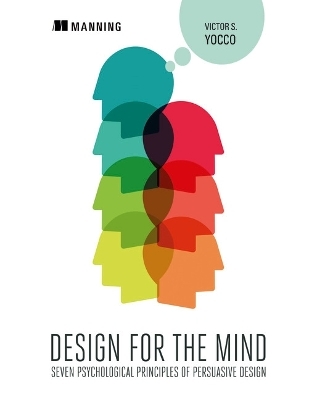
Design for the Mind
Manning Publications (Verlag)
978-1-61729-295-8 (ISBN)
- Provides insight into creating powerful user focused design
- Approachable to readers at all stages of their careers
- Empowers readers to think critically
Understanding psychological theory as it applies to digital design allows those studying to become or currently working on design teams to enhance the effectiveness of their craft, speak about how their decisions are informed by psychological theories and research, and improve the likelihood that their product will engage users as intended.
The days of purely aesthetic design are long gone. Today's web designers are driven by pertinent questions like these: How will I win the battle of the short attention span? How do I put visitors at ease and provide the information they're consciously (and unconsciously) expecting? How will the design of my site encourage users to engage, browse, or buy?
There's a body of tested psychological principles that can transform digital designs by anticipating and benefiting from how human beings react to stimuli. This scientific approach to the decision making process, attitudes to risk and reward, group influence, and more are a treasure trove ready to be applied to the field of website design.
Design for the Mind teaches web designers and developers how to create sites and applications that appeal to our innate natural responses as humans. The book introduces the most immediately relevant and applicable psychological concepts, breaks down each theory into easily-digested principles, then shows how they can be used to create powerful designs.
The idea is not to produce a use-by-rote set of patterns for digital persuasion, but to deepen the understanding of why people react in the way they do to design features and approaches. After reading the book, readers should be equipped to make their work more psychologically friendly, engaging, and persuasive.
Victor Yocco is a researcher and strategist at Intuitive Company, a user focused design and development firm located in Philadelphia, PA. Victor frequently publishes and speaks on UX research and design. He received his PhD from The Ohio State University, where his research focused on psychology and communication.
1. Meeting Users' Needs: Including Psychology in Design
1.1. Principles Included in this book
1.1.1. Design to create and change behaviors
1.1.2. Design for influence and persuasion
1.2. Criteria for inclusion in this book
1.2.1. Taught in graduate school
1.2.2. Citations: A popularity contest
1.2.3. Simplicity
1.2.4. Relevant to design
1.3. Why You Should Read this Book
1.3.1. You Will Gain Knowledge
1.3.2. You Will Learn how to Think Like Your Users
1.3.3. You Will Learn to Communicate the Needs of Users
1.4. What this Book Won't Teach You
1.5. Addressing Psychology Enhances Usability
1.5.1. What Designing Without Psychology Looks Like
1.5.2. What Designing with Psychology Looks Like
1.6. And Now, a Passionate Word on Persuasion
1.7. Talking the Talk: Conversations about psychology
1.8. Summary
1.9. Cheat Sheet
Part 2: Why do folks act like that? Principles of behavior
2. Designing for Regular Use: Addressing Planned Behavior
2.1. Introduction
2.1.1. Brief Academic Background
2.2. Key Concepts of Planned Behavior
2.2.1. People want a positive outcome
2.2.2. People want to know what others are doing
2.2.3. People want control
2.2.4. People often intend to engage in a behavior
2.3. How to Design for Users' Plans
2.3.1. Design for positive outcomes of using your design
2.3.2. Make your design socially acceptable
2.3.3. Giving users control
2.3.4. Understanding Who's in charge of the Behavior
2.3.5. Designing for Intention
2.4. Talking the Talk: Conversations about planned behavior
2.5. Case Study: Hotels.com
2.5.1. Hotels.com: Behavior Beliefs
2.5.2. Hotels.com: Normative Beliefs
2.5.3. Hotels.com: Control
2.6. End of Chapter Exercise: Applying Planned Behavior Research to Design
2.6.1. Scenario
2.6.2. Participants
2.6.3. Data
2.6.4. Questions
2.7. Additional resources
2.8. Summary
3. Risky Decisions & Mental Shortcuts
3.1. Introduction
3.1.1. Brief Academic Background
3.2. Key Concepts of Decision Making Under Risk
3.2.1. First people go through editing
3.2.2. Next, people go through evaluation
3.2.3. What impacts the evaluation of uncertain decisions people make
3.3. How to Design for Decisions Under Risk
3.3.1. Determine Users' Reference Point
3.3.2. Define and Design for Users' Decision Points
3.3.3. Design for Loss Aversion
3.3.4. Design for the Certainty Effect
3.3.5. Design for the Disposition Effect
3.3.6. How to Design for Heuristics
3.4. Talking the talk: Conversations about decisions under risk and users' mental shortcuts
3.5. Case Study eBay
3.5.1. Reference Point
3.5.2. The Certainty Effect and Scarcity Heuristic
3.5.3. The Availability Heuristic
3.5.4. The Familiarity Heuristic
3.5.5. Escalation of Commitment
3.5.6. The Scarcity Heuristic
3.6. End of Chapter Exercise: Name that Heuristic! and What's Your Product's Sticky Behavior
3.6.1. Name that Heuristic
3.6.2. Sticky Behaviors
3.7. Additional Resources
3.8. Summary
4. Motivation, Ability, and Trigger - Boom!
4.1. Introduction
4.1.1. Brief Academic Background
4.2. Key Concepts of Motivation, Ability, and Trigger
4.2.1. People Need Motivation to Complete a Task
4.2.2. People Need the Ability to complete the task
4.2.3. People Need Triggers to Engage in the Task
4.3. How to Design for Motivation, Ability, and Trigger
4.3.1. Increasing Motivation
4.3.2. Increasing Ability
4.3.3. Presenting Effective Triggers
4.3.4. Mobile Design Increases Ability
4.4. Talking the talk: Conversations About Motivation, Ability, and Trigger
4.5. Case Study: Fitbit
4.6. End of chapter Exercise: Motivation, Ability, and Triggers
4.6.1. Motivation, Ability, or Trigger
4.6.2. Design Challenge — Wearable technology to achieve better health
4.7. Additional Resources
4.8. Summary
Part 3: Principles of Influence and Persuasion: Not as Evil as You'd Think
5. Influence: Getting People to Like and Use Your Design
5.1. Introduction
5.1.1. Brief Academic Background
5.2. Key Concepts of Influence
5.2.1. Reciprocity
5.2.2. Commitment and Consistency
5.2.3. Consultation
5.2.4. Visual and Audio Influence
5.3. How to Design for Influence
5.3.1. Creating a Sense of Reciprocity
5.3.2. Activating Commitment and Consistency
5.3.3. Facilitating Consultation
5.3.4. Visual influence
5.3.5. Influence to stay away from
5.4. Talking the Talk: Conversations About Influence
5.5. Case Study: LinkedIn
5.5.1. Reciprocity
5.5.2. Commitment and consistency
5.5.3. Consultation
5.6. End of Chapter Exercise
5.7. Additional Resources
5.8. Summary
6. Using Family, Friends, and Social Networks to Influence Users
6.1. Introduction
6.1.1. Brief Academic Background
6.2. Key Concepts of Social Influence
6.2.1. Social Identity Theory —
6.2.2. Social Validation
6.2.3. Compliance
6.2.4. Conformity
6.2.5. Opinion leaders
6.3. How to Design for Social Influence
6.3.1. Users want to see what they have in common with others
6.3.2. Socially Validating Your Design
6.3.3. Getting Users to Comply
6.3.4. Encouraging Users to Conform
6.3.5. Harnessing the Power of Opinion Leaders
6.4. Talking the Talk: Conversations About Social Influence
6.5. Case Study: Drought Shaming
6.5.1. Social identity theory and drought shaming
6.5.2. Social Validation
6.5.3. Compliance
6.5.4. Conformity
6.5.5. Opinion Leaders
6.6. End of Chapter Exercise
6.7. Additional Resources
6.8. Summary
7. It's Not What You Say; It's How You Say It!
7.1. Introduction
7.1.1. Brief Academic Background
7.2. Key Concepts of Framing Communication
7.2.1. People need to understand the message
7.2.2. People need motivated by the message
7.3. How to Design for Framing Communication
7.3.1. Identify what you want to communicate
7.3.2. User Research
7.3.3. Choose a framing technique
7.3.4. Choose your frame of communication
7.3.5. Create your message
7.3.6. Test your message
7.3.7. Release your well framed message
7.4. Talking the talk: Conversations about framing communication
7.5. Case Study: BeTobaccoFree.gov
7.5.1. A Variety of Frames: The Buckshot Approach
7.5.2. Is the CDC's approach effective?
7.6. End of Chapter Exercise: Find a Frame that Works!
7.7. Additional Resources
7.8. Summary
8. Persuasion: The Deadliest Art
8.1. Introduction
8.1.1. Brief Academic Background
8.2. Key Concepts of Persuasion
8.2.1. Determining if People Pay Attention: Capability and Relevancy
8.2.2. Central Route Processing
8.2.3. Peripheral Route Processing
8.3. How to Design for Persuasion
8.3.1. Getting users to pay close attention
8.3.2. Designing for Users' Paying Close Attention
8.3.3. Designing for Users with Low Attention
8.4. Talking the talk: Conversations About Persuasion
8.5. Case Study: PayPal
8.5.1. Attention
8.5.2. High Attention
8.5.3. Low Attention
8.6. End of Chapter Exercise
8.6.1. Personas
8.6.2. Research
8.7. Additional Resources
8.8. Summary
9. Case Study: KidTech Design Company's Good Choice App
9.1. Introduction
9.2. Using Psychology to Justify an Idea
9.2.1. How Would You Use Psychology to Justify the Good Choice App
9.2.2. How KidTech Used Psychology to Justify the Good Choice App: Planned Behavior
9.2.3. How KidTech extended Planned behavior into the design of their product
9.3. Nervous Parents and Uncertain Outcomes
9.3.1. How would you reassure parents and address uncertainty
9.3.2. How KidTech addressed reassuring parents and uncertainty
9.4. Making it Social
9.4.1. How would you make the Good Choice app social
9.4.2. How KidTech made the app social
9.5. Speaking Clearly to Users
9.5.1. How would you recommend KidTech talk to users?
9.5.2. How KidTech designed their communication strategy?
9.6. Long-Term Engagment
9.6.1. How would you make users want to keep using the app?
9.6.2. How KidTech facilitated long-term use of the app
9.7. Low Use of App after Download
9.7.1. How would you help KidTech increase use after download?
9.7.2. How KidTech addressed increasing use after download
9.8. A Closer Look at Persuasion
9.8.1. How do you think the Good Choice app addresses the principle persuasion from Chapter 8?
9.8.2. How KidTech's app addresses the principle persuasion from Chapter 8?
9.9. Talking the talk: Conversations about psychological principles
9.10. End of Chapter Exercise: Critique KidTech
9.11. Summary
10. The Next Step: Getting up and Running
10.1. Part of the whole
10.1.1. Phase One: Idea Conceptualization
10.1.2. Phase Two: Design Conceptualization
10.1.3. Phase Three: Design Iteration
10.1.4. Phase Four: Post Shipment
10.2. Choosing the right principle
10.3. Making the case for psychology
10.4. UX Research Methods
10.5. Measuring Impact
10.6. Talking the talk: Your turn to discuss principles of psychology
10.6.1. Idea conceptualization
10.6.2. Choosing the right principle
10.6.3. Conducting Research
10.6.4. Measuring effectiveness
10.7. End of Chapter Exercise: Which Principle is Best for Your Design?
10.8. Additional Resources
10.9. Summary
| Erscheinungsdatum | 10.07.2016 |
|---|---|
| Zusatzinfo | illustrations |
| Verlagsort | New York |
| Sprache | englisch |
| Maße | 185 x 234 mm |
| Gewicht | 1000 g |
| Einbandart | kartoniert |
| Themenwelt | Informatik ► Software Entwicklung ► User Interfaces (HCI) |
| Informatik ► Web / Internet ► Web Design / Usability | |
| Schlagworte | Angewandte Psychologie • Design • Persuasive Strategien in den Medien • persuasive technologies • Psychologie • User Experience (UX) Design • UX Design • Webdesign • Webdesign; Webentwicklung |
| ISBN-10 | 1-61729-295-8 / 1617292958 |
| ISBN-13 | 978-1-61729-295-8 / 9781617292958 |
| Zustand | Neuware |
| Informationen gemäß Produktsicherheitsverordnung (GPSR) | |
| Haben Sie eine Frage zum Produkt? |
aus dem Bereich


